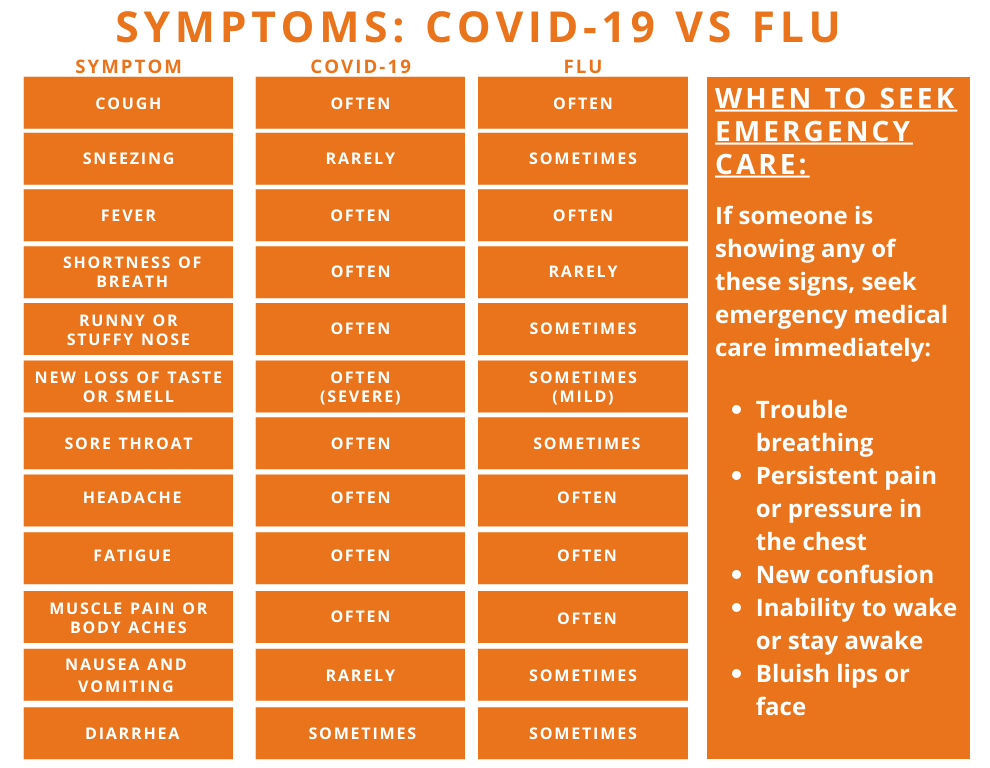COVID vs flu: How can your employees tell the difference?
This post was originally shared on AllWays Health Partners' provider blog, Best Practice.
As fall begins, so does flu season. If your employees start to feel unwell, they may wonder whether they have flu or COVID-19 symptoms. Check out our infographic to see the differences.
Flu symptoms vs COVID-19 symptoms
The CDC explains how flu and COVID-19 present and behave differently, including what kinds of symptoms each disease normally has. Here’s a chart that you can show your employees clearly explaining which disease has which symptoms, based on information from the CDC:
Sources: Flu Symptoms & Complications, Symptoms of Coronavirus, and Symptom Profiles of a Convenience Sample of Patients with COVID-19.
You can click the image to get a downloadable PDF version of this chart to share with your employees.
Other differences between flu and COVID-19
It’s not just the symptoms that differentiate flu and COVID-19. The time it takes for symptoms to appear after infection also differs between each disease. While it only takes 1–4 days after infection with flu for someone to start showing symptoms, it can take anywhere from 2–14 days after infection for COVID-19 for symptoms to appear. However, they usually appear 5 days after infection. Similarly, people with COVID-19 are contagious for much longer than people with flu. Those with flu are contagious a day before they show symptoms and up to 7 days after, and are most contagious during the first 3–4 days of the illness. While it’s not yet fully understood how long COVID-19 remains contagious, it’s been found that it’s possible to spread COVID-19 for 2 days before symptoms appear and for 10 days after they go away.
While both illnesses have similar ways of spreading, COVID-19 has been found to spread more strongly than the flu, allowing it to infect more people much faster. Both illnesses are more likely to cause complications in those who are pregnant, elderly, or have underlying medical conditions. However, COVID-19 can cause Multisystem Inflammatory Syndrome in Children (MIS-C) in school-age children, which flu cannot do.
Perhaps the most striking difference between the two diseases is the complications they can cause. Both diseases can cause pneumonia, respiratory failure, acute respiratory distress syndrome, multiple-organ failure, and other dangerous and sometimes deadly complications. But COVID-19 is different in that in addition to these, it also carries a risk of causing the aforementioned MIS-C in children or causing blood clots in the veins and arteries of the lungs, heart, legs or brain. COVID-19 may also be causing permanent damage to the heart, lungs, kidneys, and brain. Many who recover from COVID-19 continue to struggle with persistent problems like fatigue, brain fog, shortness of breath, and more, even those who are young and were healthy beforehand.
In addition, while the flu has some FDA-approved treatments such as anti-viral drugs and a vaccine, there are currently no FDA-approved treatments or vaccine for COVID-19. Studies and trials are currently in progress to find curative and preventative medicines for COVID-19, but in the meantime, social distancing and wearing masks are the best forms of protection available.
Protect yourself and others with a flu vaccineVisit our flu vaccine page to learn why it's especially important to get a flu vaccine this year, along with other important information including:
|

